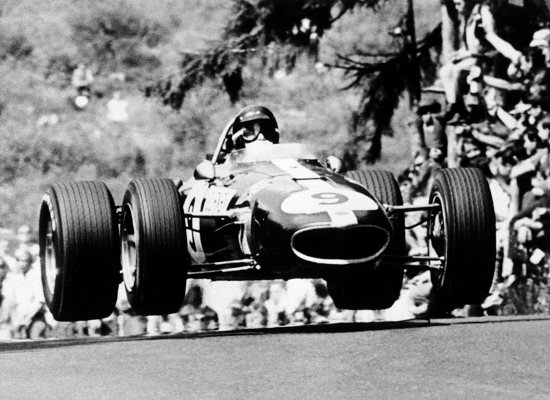The Way It Is/ Not exactly Dan Gurney at the Nurburgringby Gordon Kirby |
 It's interesting that it gets everyone's attention when IndyCar has a pack racing accident. But when NASCAR has yet another even more spectacular pack racing restrictor plate crash like Austin Dillon's at Daytona it's accepted as part of NASCAR's scenery.
It's interesting that it gets everyone's attention when IndyCar has a pack racing accident. But when NASCAR has yet another even more spectacular pack racing restrictor plate crash like Austin Dillon's at Daytona it's accepted as part of NASCAR's scenery.
Sure, everyone talks about continuing to improve the catch fences and safety in general but nobody questions the basic formula for restrictor plate racing. In fact, 'plate racing' has become institutionalized in NASCAR and the concept of 'closer, more competitive racing' has infected every other form of American racing. The theory of course, is that it appeals to the masses, if not true racing fans. From its start, the IRL embraced the concept, and IndyCar has perpetuated it while a similar approach has been adopted by United SportsCar. These days at every corner of the sport everyone talks bout how best to restrict the performance of the cars, engines, aerodynamics and tires. As far as the American public and media are concerned the image of automobile racing today is one of crowded packs of NASCAR cars pounding, plate racing style, around Daytona or Talladega. Most of the media pump it up as the most fantastic form of racing known to man, but to many race fans who are not fans of NASCAR it's totally contrived, stupidly dangerous and absurdly expensive to the teams in crashed or destroyed cars.  © LAT USA Almost thirty years ago I wrote a book with Emerson Fittipaldi titled 'The Art of Motor Racing'. In the book Fittipaldi wrote about his passion for the sport and what he believes drives people to race cars. "Motor racing," Emerson wrote, "is a fantastic sport full of magnificent sensations--controlling and sliding the car at high speed, on the limit, and competing against other cars and drivers. I think it is one of the most artistic of all sports. It requires that you take everything out of the car and yourself. It requires you to give the maximum of your intelligence and feelings. These things make motor racing an art and a great sport for a young person to enjoy." Yet in this day and age, amid the roiling image of NASCAR plate racing, the skills that Gurney personified and Fittipaldi wrote about have vanished from view. To today's average sports fan, auto racing is about having a heavy right foot and the ability to barge through holes that may not be there. There's no awareness of the subtleties of driving and racing or the importance and value to the likes of Gurney and Fittipaldi of aesthetics and elegance. Nor do I believe there's any hope that the American public or media will rediscover the appeal of motor racing as we once knew it. We've moved into a different era and a different definition of the sport. Blame certainly rests at the feet of the USA's various automobile racing sanctioning bodies for embracing NASCAR's spec car and close racing mentality rather than daring to pursue their own philosophies which might make them different, or even unique, as well as more appealing to a wider audience. Bravery and the desire to do your own thing drove motor racing through most of it's grand history and it's sad to see the absence of those virtues in the sport's contemporary halls of power. But, as I've written before, something else about our culture as a whole is at play in the uninspiring, inelegant state of modern motor racing in America. Looking back on the achievements of Dan Gurney and All American Racers almost half a century ago emphasizes the fact that in the past thirty years American drivers, teams and cars have had zero impact on international motor racing.  © AAR/Werner Eisele The last American driver to win an F1 race was Michael's father Mario when he won the Dutch GP in 1978--thirty-seven years ago--on the way to winning the world championship with Lotus. The last American team to score an F1 win was Penske Racing at the Austrian GP in 1976--thirty-nine years ago--with Irishman John Watson driving Penske's final F1 car, the PC3. And the last American drivers and team to win the Le Mans 24 hours were Dan Gurney and A.J. Foyt with Carroll Shelby's factory Ford team back in 1967--forty-eight years ago. Those stark facts clearly plot the decline of American drivers and teams in international motor sport from the historic high point when Gurney won the Belgian GP at Spa in 1967 and set a track record while leading the following year's German GP at the Nurburgring. Our sanctioning bodies have played significant roles in the sport's decline but the story is much bigger than that. We've fallen a long way since the heydays of Gurney, Andretti, Phil Hill, Richie Ginther and Carroll Shelby, and on current evidence there's nothing to suggest that any of the great international feats achieved by these men will ever be repeated. Nor does it seem likely that we'll see any of our sanctioning bodies cast off the yoke of NASCAR thinking and reinvent themselves as something unique in the innovative spirit of Dan Gurney and All American Racers' beautiful and inspiring line of Eagle race cars. |
|
Auto Racing ~ Gordon Kirby
Copyright ~ All Rights Reserved |
